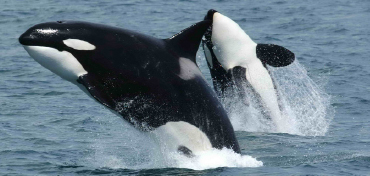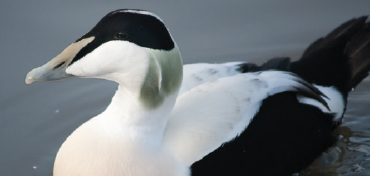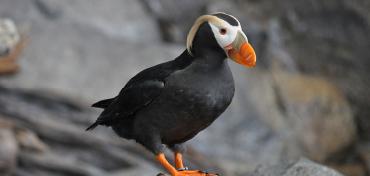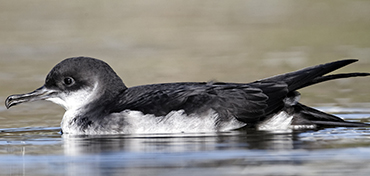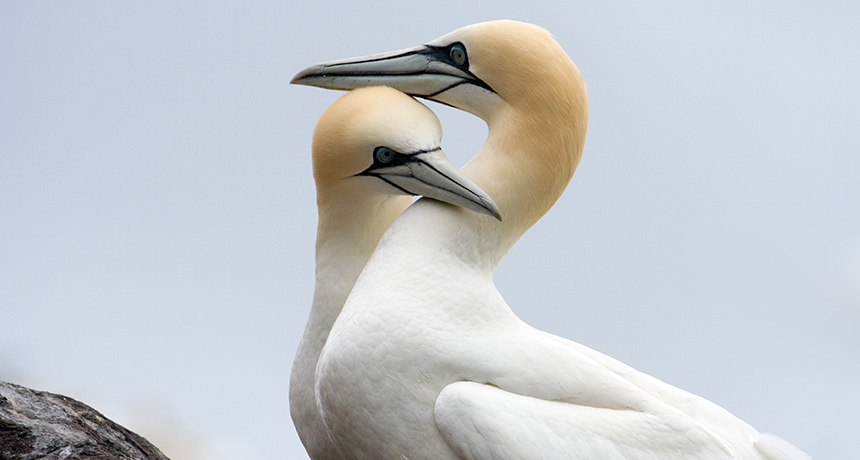
WRONG OCEAN Northern gannets are just one of the species with a stray individual or more suspected of journeying through the melting Arctic to new territory.
Keith Marshall/Flickr (CC BY-NC-SA 2.0)
One whale spotted in the wrong ocean seemed merely odd. But a second misplaced whale looked more like a sign of an ecological shake-up: Pacific Ocean fauna moving into the Atlantic Ocean and vice versa. As the Arctic’s icy barriers melt, new waterways may soon allow many formerly separated animals to move and mix.
“We do believe we’re seeing a faunal exchange,” says Seabird McKeon of the Smithsonian Marine Station in Fort Pierce, Fla.
Species moving from one ocean might disrupt life in the other — competing with some longtime residents, preying on others — or maybe change hardly anything. “We just do not know what’s going to happen,” McKeon says.
He and seven other scientists compiled from various sources several years’ worth of wrong-ocean sightings of whales and birds suspected to have crossed the Arctic or mingled with counterparts from the opposite ocean. The compilation, published online November 30 in Global Change Biology, isn’t big. But for long-lived creatures such as whales and some seabirds, a trickle of animals could establish a new population.
“Even if the strays are few, even if it’s a very slow process, there is a chance of establishment,” McKeon says. “That’s why we’re excited for people to really start watching this process.”Birders, whale watchers and other citizen scientists offer the best hope for catching early signs of any species moving across the Arctic. “If an individual bird ends up in an alternative ocean basin, that is not something that is likely to be picked up by standard scientific programs,” McKeon says.
In the past, thick permanent sea ice in the Arctic plus potentially lethal water temperatures, scarce food, unusual salinity and other menaces have acted as a barrier between oceans, largely blocking animal journeys for the last 3 million years. But climate change is opening up a path. The 10 skimpiest minimums for summertime ice observed since the satellite era began have all occurred in the last 11 years, NASA analyses show.
Summer ice has dwindled enough on occasion, such as in 2012, to raise commercial hopes of workable waterway passages for shipping. Feasible paths are opening in successive years through the archipelago of islands in eastern Canada, and other routes may form, too, so trade ships in coming decades may be able to shortcut through the summertime Arctic.
Human commerce and the politics of climate change get more widespread attention than the chance that animals will venture along the new routes. But rearranging species’ ranges could have sweeping consequences, too.
A notorious example of the unintended troubles that range changes can cause comes from the Suez Canal in Egypt. The canal “has been singularly successful as an invasion corridor,” says Bella Galil of the National Institute of Oceanography in Haifa, Israel.
Of nearly 700 alien species now found in the Mediterranean Sea, half have arrived through the canal since it opened in 1869, Galil reported in the April Biological Invasions. In summer, swarms of nomad jellyfish (Rhopilema nomadica), originally from the Red Sea, clog fishing nets and block intake pipes at desalinization and power plants in Israel. Another newcomer, the poisonous Lagocephalus sceleratus puffer fish, puts several people in the hospital each year. And introductions such as the goldband goatfish and a kind of spiny oyster have wiped out their native counterparts.
In contrast, the Panama Canal shepherds traffic through locks filled with freshwater, which reduces the risk of saltwater Pacific species sloshing through to the Caribbean Sea and vice versa. And thank goodness. McKeon says he has heard discussions about whether a saltwater canal in Panama would have let the venomous sea snakes from the Pacific wriggle their way into the Caribbean.
In the rapidly changing Arctic, at least one Pacific species has already established populations on the North Atlantic side for the first time in about 800,000 years. Microscopic strings of silica-encased Neodenticula seminae diatoms turned up in the late 1990s in the Labrador Sea, an international research team reported in 2007. The researchers argue against the notion that the diatoms merely hitchhiked in some ship’s ballast water. Instead, the diatoms’ presence could be a sign that ocean circulation patterns are changing in the Arctic, swirling water and its living residents across the pole. What the diatoms will do Atlanticside isn’t clear, but they have now spread to northern Nordic waters, a paper published in 2013 reports, where there’s no sign they have ever been before.
Story continues below map
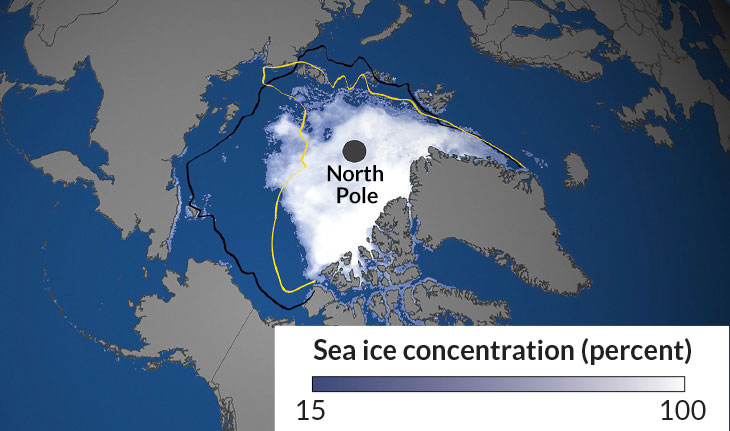
In 2010, a marine-mammal monitoring program photographed a gray whale off the coast of Israel. “It was really a huge surprise to everybody,” says Elizabeth Alter of York College CUNY in Jamaica, N.Y., a coauthor with McKeon on the new paper. “There was discussion at first of whether the photos might have been photoshopped.” (They were not, it turned out.)
In 2013, a monitoring group sighted another gray whale along the coast of Namibia. It seems improbable that gray whales from the northern Pacific had looped down to the Southern Hemisphere to swim around continents and then into the Atlantic, Alter says. She suspects the whales were feeding along the Arctic coastline as they normally do, and without much ice to block their progress, inadvertently hugged the coast all the way to the Atlantic side.
SEA ICE, THE MOVIE Satellite data reveals how the annual minimum area of Arctic sea ice has fluctuated during Septembers from 1979 to 2014. NSIDC |
Should gray whales eventually recolonize the Atlantic, McKeon expects that their new neighbors would notice. Unlike similar whales with baleen plates in their mouths, grays gulp whale-sized mouthfuls of soft sea-bottom gunk to savor its hidden crustaceans. In the course of dining, the whales stir up sediment, scattering clouds of invertebrates that other species eat and leaving behind whale-gouges as habitat. It’s impossible to know the impacts, but McKeon speculates on what could happen to the blue crabs that bury themselves in the mud at the mouth of the Chesapeake Bay in winter: “I can’t imagine anything much better as a snack for a wintering gray whale than sleepy blue crabs.”
Melting may also bring new opportunities to another whale species, the bowheads, which live in the Arctic full time. “They can break ice that’s 2 feet thick with their heads,” Alter says. The Atlantic and Pacific bowhead populations have shared genes over the last several thousand years, Alter’s DNA studies show. And in 2010, biologists tracking both populations by satellite found a whale from each population feeding near each other. After about a week, the whales retreated in opposite directions, but left clear evidence that the melting Arctic permits populations from separate oceans to mix.
Also on McKeon’s list of possible vanguards of Arctic crossovers is a northern gannet, a plunge-diving, fish-eating seabird that soars over the Atlantic with a wingspan of about 2 meters. “What every gull dreams of being,” he says. In 2011, one of these gannets showed up off the coast of Alaska. Possibly the same bird reached the Farallon Islands along northern California. The most plausible explanation, McKeon says, is that the bird had worked its way through some avian northwest passage with open water for fishing along its flight path.
Open water in the Arctic could also move animals indirectly. As summer sea ice shrinks more and more, shipping could boom along Arctic routes. These ships take on ballast water in one place and release the ballast in another, letting animals (smaller than whales) catch a lift, says Jacqueline Grebmeier of the University of Maryland Center for Environmental Science. The prevailing wisdom has been that stowaways wouldn’t survive the harsh Arctic, but as the Arctic climate changes, Grebmeier can imagine circumstances now in which ballast creatures might. Whales and charismatic seabirds may be easier to spot when they switch oceans, but ballast stowaways may turn out to be more common. And as important.
